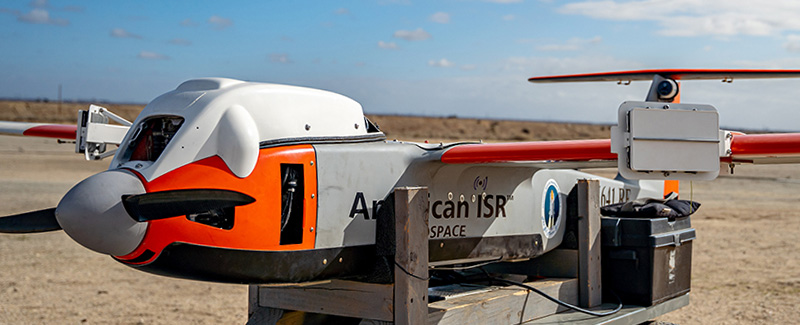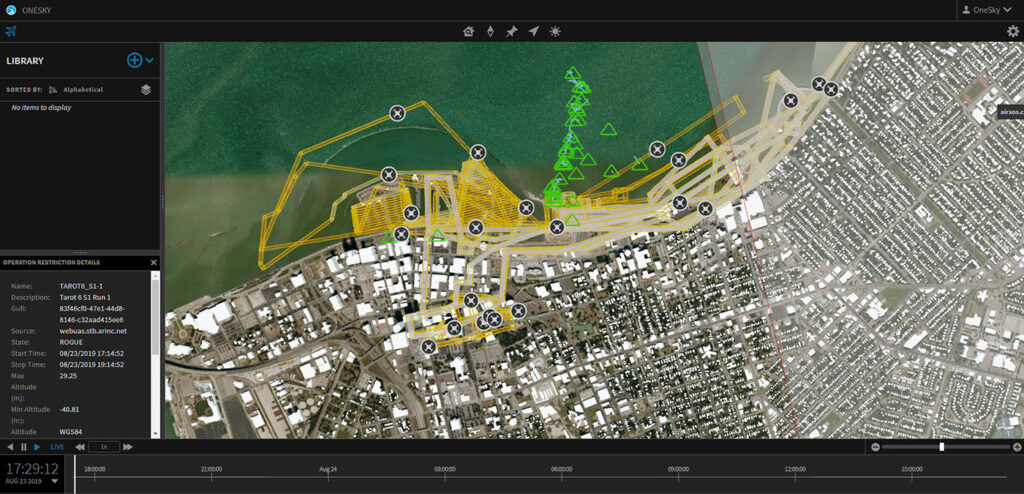Echodyne Joins OneSky Future of Flight Program


Echodyne is the newest member of the OneSky Future of Flight Program. (Photo: OneSky/Echodyne)
OneSky recently announced Echodyne as a new member of the OneSky Future of Flight Program. This is a coalition of stakeholders in the advanced air mobility (AAM) industry working towards scalable AAM operations.
Echodyne’s MESA radar technology plays a crucial role in providing high-precision airspace data for the AAM industry, addressing the challenge of format and affordability. By miniaturizing large defense radar performance into a compact, commercially-priced format, Echodyne offers exceptional situational awareness to manufacturers and operators of small uncrewed vehicles as well as to UTM providers and ground stations.
The partnership aims to enhance operational safety and enable beyond visual line of sight (BVLOS) operations by integrating Echodyne’s radar data with OneSky’s UTM platform. The Future of Flight Program, with Echodyne as a key partner, envisions a collaborative effort to deliver total situational awareness for UAS operators and further advancements in airspace deconfliction.
In an interview with Avionics International, Michael Tornetta from OneSky and Leo McCloskey from Echodyne shed light on the collaboration and on their respective platforms. Check out our Q&A with Tornetta, Head of Sales and Strategic Growth at OneSky, and McCloskey, VP of Marketing at Echodyne, below:
Avionics: How does Echodyne’s MESA radar technology contribute to high-precision airspace data for the AAM industry?
Leo McCloskey, Echodyne: Airspace safety centers on situational awareness built upon data fidelity. Radar is the essential data foundation. No other sensor deconflicts both cooperative and noncooperative airspace traffic. The challenge is not the advanced air mobility (AAM) industry’s desire for high-performance radar, but rather format and affordability.
The primary hurdle for extending radar beyond traditional defense and national security applications has been largely fitness for market: AAM requires tracking hundreds of small objects at relatively close range, whereas traditional radar focuses on jets, missiles, and ships at great distance.
Echodyne’s innovative metamaterials electronic scanning array (MESA) technology is the first to miniaturize large defense radar performance into a compact, solid-state, commercially-priced format, delivering exceptional airspace situational awareness performance for unmanned aerial vehicle (UAV) manufacturers, ground stations, UAS traffic management (UTM) providers, and unmanned aircraft system (UAS) mission operators. Echodyne’s MESA technology delivers national security radar performance at commercial prices.
What led Echodyne to join the OneSky Future of Flight Program?
McCloskey: The Future of Flight program represents the cooperative energy required to solve the highly complex challenge of ensuring safety when dozens, hundreds, even thousands of other novel aircraft operate in dense airspace over population. For this to be possible, a huge amount of data will need to be consumed by operators and autopilots.
UAS traffic management (UTM) as a concept is pivotal to airspace safety, with data fidelity creating ever safer and more numerous AAM operations. OneSky’s UTM platform is built on extraordinary data fidelity of operational areas, with the level of accuracy required to detail high performance radar data. We’re excited to contribute to OneSky’s Future of Flight vision.

EchoFlight radars on AATI (American Aerospace Technology Inc.) aircraft (Photo: Echodyne)
Could you discuss the specific benefits that Echodyne’s ground-based and airborne radar solutions bring to aircraft operators in terms of deconfliction capabilities?
McCloskey: Airspace safety is all about data fidelity. A “something is over that way” level of accuracy is grossly insufficient to the mission requirement of detecting, classifying, and tracking dozens and hundreds of small and large aircraft moving about in congested airspace. Echodyne radar brings defense- and national security-level accuracy to commercial markets in commercial formats for the first time.
The regulations that will outline performance requirements for industry remain uncertain and perhaps not as close as industry might like. Still, a few things are becoming clear:
- It’s unlikely that small drones (<55 pounds) will have the payload or power capability for even the smallest radars, leading many to conclude the answer is a data utility that integrates sensors into UTM solutions for single screen flight management.
- Larger aircraft for flying people and goods are highly likely to require much more sophisticated sensors on the aircraft, with operational safety also benefiting from ground sensors and UTM solutions.
- Lifecycle management and maintenance of this infrastructure will be important, with clear benefits for solid-state radar like Echodyne’s.
In what ways does the integration of Echodyne’s radar data into the OneSky system enhance operational safety and enable beyond visual line of sight (BVLOS) operations?
McCloskey: Single pane of glass flight management is important for minimizing operator distraction. UTM represents the higher-level collection of all available data, from filed flight plans to data from lower-level components such as Remote ID, Automatic Dependent Surveillance-Broadcast (ADS-B), and radar. OneSky’s UTM precision aligns well with Echodyne’s data accuracy to provide operators with the data fidelity that ensures AAM mission safety and success.

“We seek out the key industry players that we feel provide the biggest value to these stakeholders.” (Photo: OneSky)
How does the Future of Flight program benefit from partnerships with innovative companies like Echodyne?
Michael Tornetta, OneSky: As the industry, regulatory environment, and our customers evolve, it will be imperative that our technology works “out of the box” with all the systems that will be part of the AAM/UAM (urban air mobility) ecosystem. Obviously, we can’t cover everything all at once, so we seek out the key industry players that we feel provide the biggest value to these stakeholders, and we start collaboration exercises as early as possible.
The rapport we build with our partners then extends to more collaborative business development, and as partners, we build on our combined success. This brings tremendous value to the end customers because now they have essentially two trusted advisors who double as their technology providers/vendors, and they can bonus off our combined experience and industry knowledge.
Can you explain how the combined systems of OneSky and Echodyne provide total situational awareness for UAS operators and enable more advanced airspace deconfliction?
Tornetta: One of the functions of the OneSky UAS Traffic Management (UTM) platform and OneSky Operations Center is to provide airspace visualization. The total air picture needs relevant GIS data, aeronautical information, weather data, etc. The next layer is to capture, display, and record what’s actually moving in the airspace. We can do this by pulling in data feeds from the drone’s ground control system (GCS) so we know where “you” are, but we need other data feeds to determine the heading and location of other aircraft.
Automatic Dependent Surveillance-Broadcast (ADS-B) feeds from available sources, and surveillance tracks from systems like Echodyne’s help complete this air picture. The OneSky systems then provide alerts, warnings, and other capabilities to inform the flight authorization process.
Looking ahead, what are the future plans or developments that OneSky envisions through the Future of Flight Program, particularly in collaboration with Echodyne?
Tornetta: OneSky and Echodyne are just getting started. We have at least one customer in common right now and are teaming up on a handful of others for later this year.
I envision that we will continue to integrate more of the Echodyne portfolio of detect and avoid (DAA) products, as well as improve upon the existing integrations.
The post Echodyne Joins OneSky Future of Flight Program appeared first on Avionics International.
—————
Boost Internet Speed–
Free Business Hosting–
Free Email Account–
Dropcatch–
Free Secure Email–
Secure Email–
Cheap VOIP Calls–
Free Hosting–
Boost Inflight Wifi–
Premium Domains–
Free Domains





